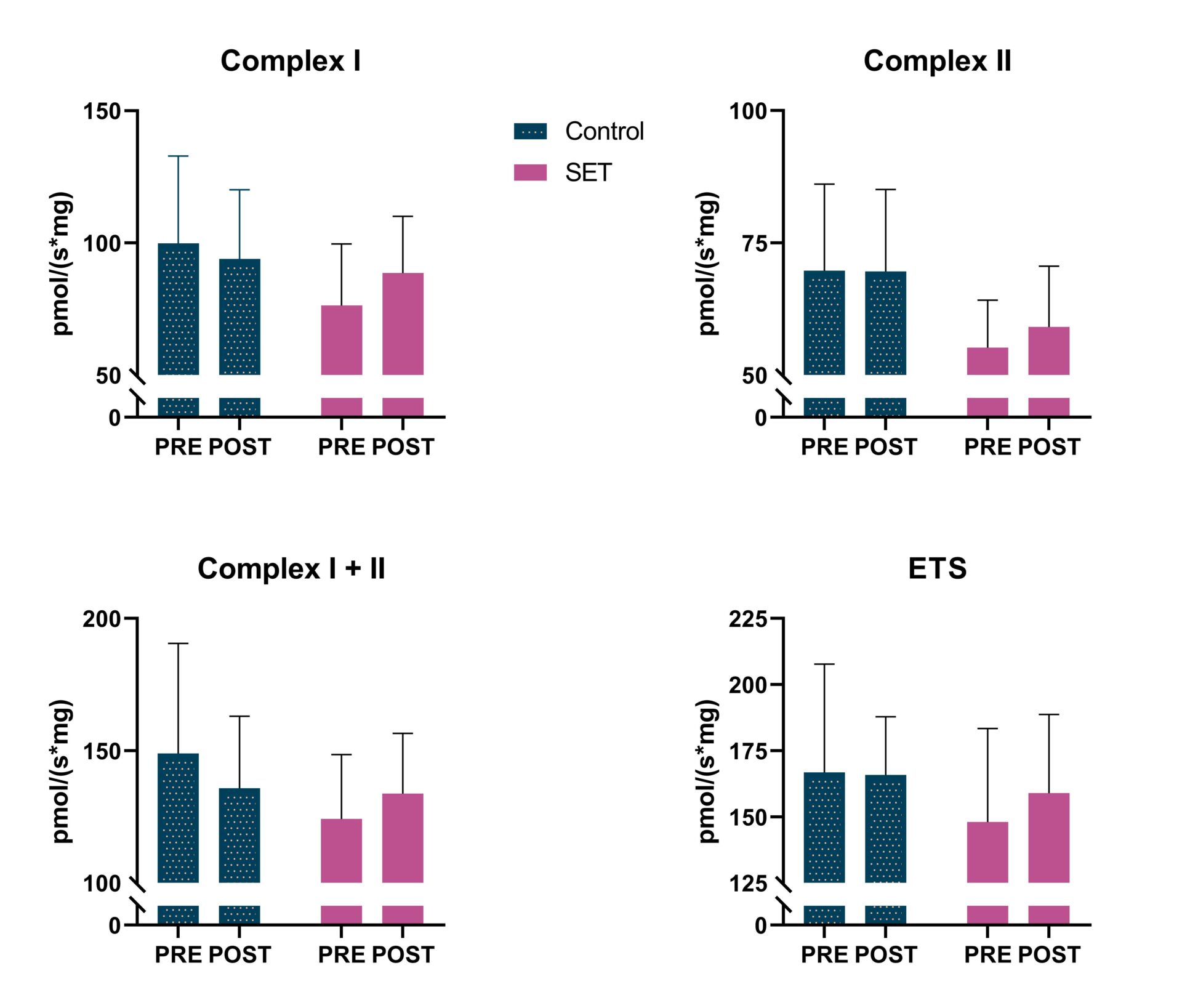Introduction
Given that performance in endurance events relies heavily on aerobic metabolism, endurance athletes need to possess a high oxidative capacity of skeletal muscle. While it is well-described that exercise training induces mitochondrial biogenesis and enhances muscle oxidative capacity (1,2), there is still debate as to the importance of training intensity versus volume in inducing mitochondrial biogenesis and enhancing mitochondrial respiratory capacity (2,3,4). This is particularly important to examine in endurance athletes, as this population often has a high training volume for which most of the training is conducted at low-to-moderate intensity. Herein, we examined adaptations in mitochondrial respiratory capacity following 6 weeks intensified training consisting of speed endurance training (SET) and a reduction of the overall training time spend at low-to-moderate intensity in highly-trained cyclists. We hypothesized that an increased training intensity would compensate for a reduction in training volume and thus maintain mitochondrial respiratory capacity.
Methods
We enrolled 14 endurance-trained cyclists (mean ± SD; Age: 25±6 years, height: 183±6 cm, weight: 74±9 kg, and VO2max: 69±4 mL×min–1×kg–1, training volume: 457±157 min/week) and randomly assigned them to either 6 weeks of maintained training intensity and volume (CON) (n=7) or a SET group (n=7), consisting 2 weekly sessions of 6 repetitions 30 s sprints, separated by 3 min active recovery. In the SET group, weekly training volume was reduced by 25%. Resting skeletal muscle biopsies were obtained from the vastus lateralis before and after the 6-week intervention for measurement of mitochondrial respiratory capacity using high-resolution respirometry in permeabilized muscle fibers. V̇O2max was measured before and after the intervention and determined as the highest value achieved during any 30 s period. Weekly training time were compared by a paired t-test. A linear mixed model for repeated measurements was used to estimate within- and between-period effects of OXPHOS capacity and VO2max. The level of significance was set to P≤0.05. Data are presented as means±SD. The study was approved by the local scientific ethics committee of Copenhagen (H-18007889) and was performed in accordance with the Helsinki II Declaration.
Results
Weekly training volume did not change (P=0.3) during the intervention in CON (-38±31 min), while it declined (P<0.001) by 26 % (-122±26 min) in SET. Respiratory capacity was similar between the groups at baseline. No changes in respiratory capacity of complex I, II, I+II or ETS were observed in any of the groups with the intervention (CI, CII, CI+II, ETS: CON: -6% (-6±35 pmol/(s×mg)) -9% (-13±47 pmol/(s×mg)), -1% (-1±39 pmol/(s×mg)), 0% (0±22 pmol/(s×mg)); SET: 16% (12±15 pmol/(s×mg)), 8% (10±18 pmol/(s×mg)), 7% (11±24 pmol/(s×mg)), 7% (4±16 pmol/(s×mg)), respectively). V̇O2max did not change in any of the groups during the intervention (-0.3±4.9 and -0.3±3.9 mL×min–1×kg–1 for CON and SET, respectively).
Conclusion
Collectively, these findings suggest that an increased training intensity using SET maintains skeletal muscle mitochondrial respiratory capacity and V̇O2max despite a reduced training volume in endurance-trained cyclists
Biomedical Basis of Elite Performance 2022 (University of Nottingham, UK) (2022) Proc Physiol Soc 49, OC4
Oral Communications: Six Weeks of Intensified Training maintains Mitochondrial Oxidative Capacity despite a Reduced Training Volume in Highly-Trained Cyclists
Jan Sommer Jeppesen1, Kate Wickham1,2, Ylva Hellsten1, Jens Bangsbo1, Morten Hostrup1
1 The August Krogh Section for Human Physiology, Department of Nutrition, Exercise and Sports (NEXS), University of Copenhagen, Copenhagen 2 Environmental Ergonomics Laboratory, Department of Kinesiology, Brock University, St. Catharines
View other abstracts by:
Where applicable, experiments conform with Society ethical requirements.

